Irish Stone Circles
Circles at Slieve na-Griddle; at Lough Gur; at Newgrange—Druid's Seat and Circle, Killiney
From A Hand-book of Irish Antiquities by William F. Wakeman
« Raths or Duns | Contents | Early Christian Antiquities »

TONE Circles of great magnitude are to be seen in many parts of Ireland. Of the lesser kind numerous examples occur in various counties, and particularly in the north. They are composed of rough, unhewn stones, varying in height from two to seven or nine feet above the level of the adjoining land, and, in some instances, are encompassed with a low earthen mound and ditch. Their area, though usually unoccupied, is occasionally found to contain one or other of the following remains:
1. A cromlech, as at the "Broadstone," parish of Finvoy, county of Antrim.
2. A tumulus, or cairn, as at Newgrange, Dowth, and other places.
3. A smaller circle, or circles.
4. Stone pillars.
Human bones, cinerary urns, ashes, weapons of flint, &c., are almost invariably discovered upon the earth within these enclosures being disturbed. The urns are enclosed within small stone kists, and are rarely found at a greater depth from the surface than about one foot, or eighteen inches.
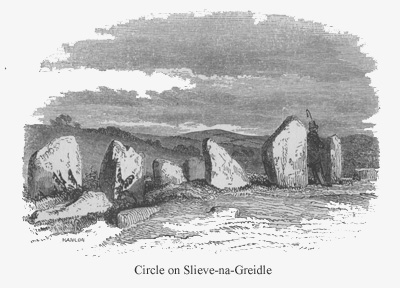
The avenue of stones by which some British circles appear to have been connected together, is rarely found in Irish remains of the same class. Indeed we only know of one instance in which such a passage appears, and even there it cannot be traced to any great distance. It runs in a northeasterly direction from the circle upon Slieve-na-Greidle, or Griddle Mountain, near Downpatrick, in the county of Down. The stones of which it is formed are smaller than those of the circle, from which it extends to a distance of about thirty-five feet. The finest remains of the class under notice which we have seen in Ireland, lie near the shore of Lough Gur, at a short distance to the north of the little town of Bruff, in the county of Limerick.
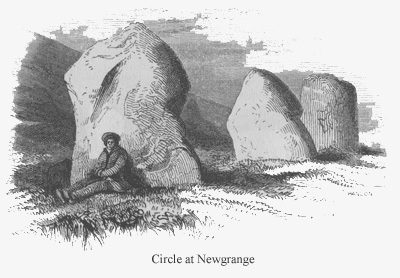
The stones which encompass the mounds of Newgrange and Dowth are generally very large, some of them measuring eight or nine feet in height. The engraving represents a portion of the circle at the former place, of which we have already given a description, see page 21. There are several minor circles in the same neighbourhood, but they are in a great state of dilapidation, and, with one exception, would scarcely repay the student for the time occupied in visiting them, particularly as the finer remains at Newgrange lie so close at hand.*
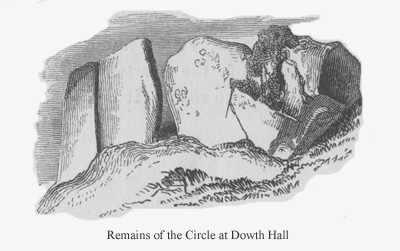
A noble circle, encompassing a cromlech, formerly stood upon Dalkey Common, but it has disappeared, the stones having been blasted and quarried by some public contractor, engaged in the erection of the Martello Tower near that place.† This outrage occurred about the year 1797, when Dalkey was almost a desert. Since then scores of houses, walls, &c., have been built upon the common with the stone of the district, which is yet so abundant that material for the erection of a city might be removed, and hardly missed.
DRUID'S SEAT
A singular pile of stones, popularly called "The Druid's Judgment Seat," stands near the village of Killiney, not far from the Martello Tower, upon the opposite side of the road. It was formerly enclosed within a circle of great stones, and a ditch.
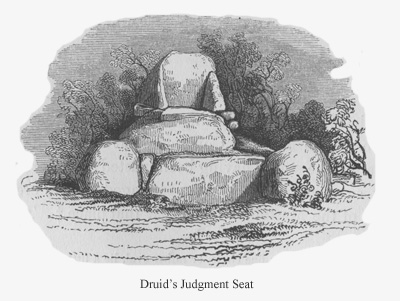
The former has been destroyed, and the latter so altered that little of its ancient character remains. "The Seat" is composed of large, rough granite blocks, and, if really of the period to which tradition refers it, an unusual degree of care must have been exercised for its preservation. The stones bear many indications of their having been, at least, re-arranged at no very distant period. Small wedges have been introduced as props between the greater stones. The right arm is detached from the other part, to which it fits but clumsily. The whole, indeed, bears the appearance of a modern antique, composed of stones which once formed a portion of some ancient monument. One great evidence of its being a forgery consists in the position which it occupies near the eastern side of the enclosure, while the back of the seat is turned towards the west, and towards the centre of the space anciently encompassed with the stone circle.
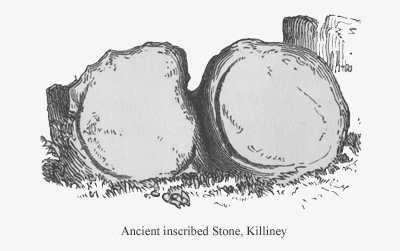
The following are its measurements: breadth at the base, eleven feet and a half; depth of the seat, one foot nine inches; extreme height, seven feet. Of several detached stones, standing within the enclosure, we have engraved one remarkable for the form into which it has been cut. It is a work probably coeval with the ancient circle, and symbolical of the sun and moon.
« Raths or Duns | Contents | Early Christian Antiquities »
NOTES
* The remains of a fine circle, or rather oval, lie a little to the east of Dowth Hall, to the left of the road from Drogheda. Many of the stones have been removed, but several of great size remain in their ancient position—See engraving above.
† Dublin Penny Journal, vol. ii, page 308.
